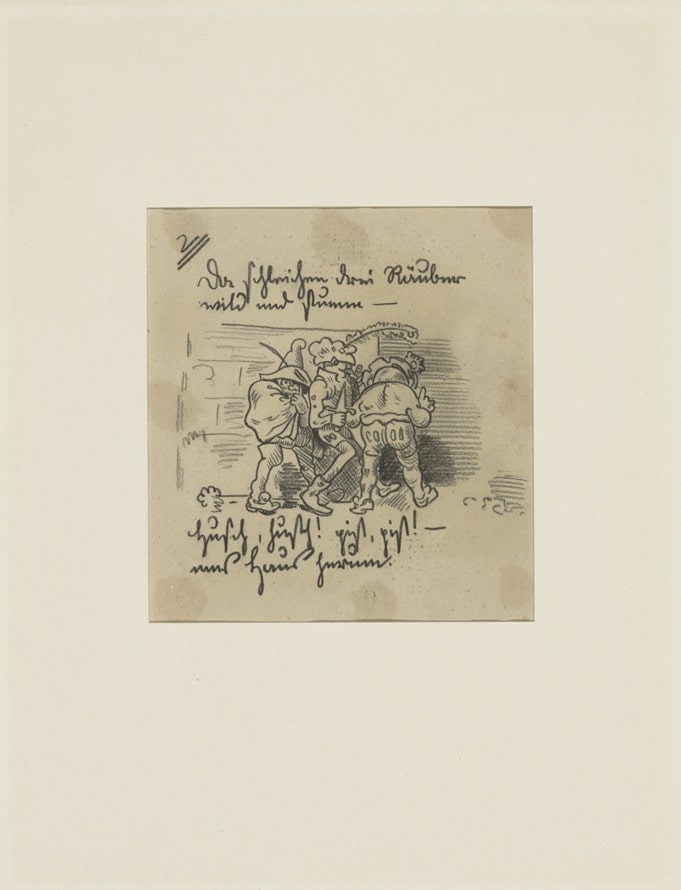For 80 years, Wilhelm Busch’s drawing “Die drei Räuber” (The Three Robbers) was considered lost. Now it has reappeared on the Swiss art market and has been donated by the former owner of the work to the Kupferstichkabinett (Museum of Prints and Drawings) of the Staatliche Museen zu Berlin (Berlin State Museums).
Image above: Wilhelm Busch, Die drei Räuber (aus: Die kühne Müllerstochter), 1868, Schwarze Kreide auf Papier (vélin), 14,7 x 13,8 cm, © Staatliche Museen zu Berlin, Kupferstichkabinett / Antje Penz.
In spring 2025, a private collection from Winterthur was consigned for auction at the Koller auction house in Zurich. During his research, Franz-Carl Diegelmann, head of the Old Prints and Drawings department, discovered that the drawing “Die drei Räuber” (The Three Robbers), based on Wilhelm Busch’s poem “Die kühne Müllerstochter” (The Bold Miller’s Daughter), had formerly belonged to the Berlin Kupferstichkabinett (Museum of Prints and Drawings) and had been lost during the turmoil of war. The auction house then contacted the museum, which confirmed the war loss. After discussions between the auction house and the owner of the drawing, she agreed to donate the work to the Kupferstichkabinett.
The “Three Robbers” illustrate the poem “Die kühne Müllerstocher” (The Bold Miller’s Daughter) by Wilhelm Busch (first published in 1868 in volume 20 of the magazine “Über Land und Meer”). It is the second sheet in an eleven-part series about a gruesome event. The accompanying text reads: “Three robbers sneak wildly and silently / – Hush, hush! Pst, pst! – around the house.“ The miller’s daughter notices the nighttime intruders and knows how to defend herself. The last picture is accompanied by a summary in the text: ”So the three died quite unexpectedly. / O, young man! Look here!!! / How a single girl often brings / Three men to their doom!!!!”
In 1909, the Kupferstichkabinett purchased this and other drawings directly from the artist’s heirs for the planned Busch exhibition of the Verein der Berliner Künstler (Association of Berlin Artists). In 1945, the drawing was moved to the basement of the Reichsbank along with other works. Since then, it was considered lost. Now it is once again part of the museum’s collection.
Dagmar Korbacher, Director of the Kupferstichkabinett: “We are particularly delighted that this work has returned to the Kupferstichkabinett. With its onomatopoeic rhyme and the strikingly inconspicuous robbers sneaking around the house, the print still makes us smile and reflect in the best Wilhelm Busch tradition. We would like to express our gratitude to the generous interim owner and the attentive experts at the auction house, whose careful work and sense of responsibility made this return possible.”
Franz-Carl Diegelmann, head of the Old Prints and Drawings department at Zurich auction house Koller, which initiated the return: “I am delighted that Wilhelm Busch’s caricature has now found its way back to the Kupferstichkabinett Berlin exactly eighty years after the end of the war. Having studied art history in Berlin, I have felt a special connection to the museum and its magnificent collection for many years and was very happy to assist in the recovery of the drawing.”
Marion Ackermann, President of the SPK: “I would like to thank the Swiss auction house Koller not only for its meticulous provenance research, but also for making it possible, through its contact with the former owner, to donate this special sheet by Wilhelm Busch to the Kupferstichkabinett. This allows the museum at the Kulturforum to once again fill a gap in its collection that was torn open by the turmoil of war.”
Anna Pfäfflin, curator for 19th-century art at the Kupferstichkabinett: “In his ballad, Wilhelm Busch describes a surprising twist. Because sometimes things turn out quite differently than expected. It is not the miller’s daughter who is the victim of the robbery, but the robbers who end up dead. And what was considered a war loss finds its way back into the museum and thus back into public ownership thanks to fortunate circumstances and private generosity.”
WHERE?
Gemäldegalerie, Kunstbibliothek, Kunstgewerbemuseum, Kupferstichkabinett
Staatliche Museen zu Berlin – Preußischer Kulturbesitz
Stauffenbergstraße 41
D-10785 Berlin






